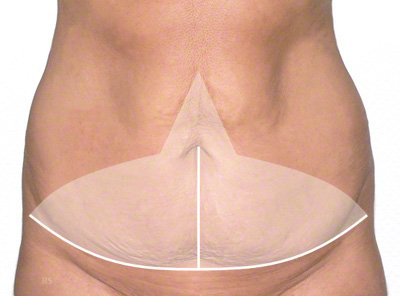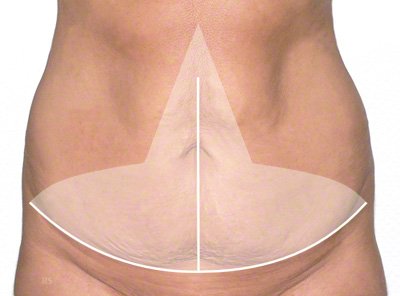The tummy tuck, or abdominal wall tightening, is also known as abdominal plastic surgery, abdominal wall plastic surgery or, medically, as abdominoplasty. The following types can be differentiated:
- Classical tummy tuck = abdominoplasty with mobilization to the costal arch (lower rib cage) and repositioning of the navel.
- Mini tummy tuck = mini abdominoplasty with mobilization only to a little above the navel, which is not repositioned.
- Inverted T-incision = large abdominoplasty with an additional vertical incision line. This incision is required in cases of massive skin excess.
- Upper tummy tuck with the incision in the area of the inframammary fold. This surgery is seldom performed because of problematic scar tissue build up.
Content
Yuveo Klinik
Characteristics of tummy tuck
The belly button does not have to be moved for every surgical technique we use at the Yuveo Clinic Düsseldorf.
Classical tummy tuck
Mini tummy tuck
Massive excess of skin
Tummy tuck surgery
The basic principle of the tummy tuck consists of the removal of excess skin and fat tissue.
This is accomplished by means of an incision that runs over the mons pubis and then laterally upward in the direction of the iliac wings. The line can be adjusted for bikini or panties.
To mobilize as much skin as possible, the fat tissue must be detached from the abdominal wall – all the way to the lower margin of the breast bone, in fact. Only in this manner can the tummy tuck be extended to the upper abdominal area.
The navel is excised and sutured into its new location. Of course, one tries to produce as little scar tissue as possible and to avoid vertical scars in the midline from the mons pubis to the navel as far as possible.
However, there are conditions that necessitate a tummy tuck using the additional midline scar:
- Small tummy tuck: Sometimes it is not possible to remove enough skin to hide the previous naval position using the transverse scar. The defect is then closed with a small vertical seam.
- Large tummy tuck: Here the excess skin is so large, that skin must be removed in the vertical direction as well, resulting in a midline vertical scar. The pattern resembles a lily, hence this technique is called “fleur-de-lis.”
To conserve tissue when a large amount of fat deposits are involved, it is preferable to remove the fat apron (see below) by means of a classical abdominoplasty.
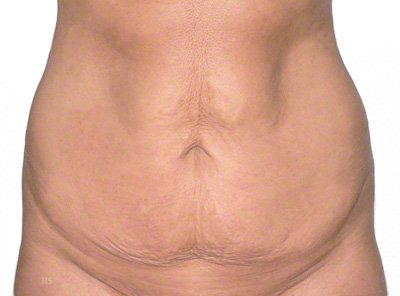
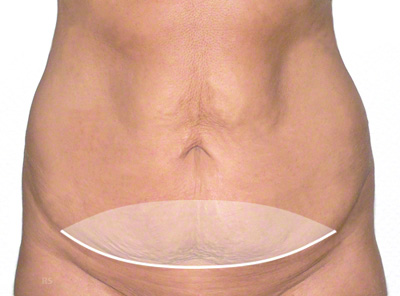
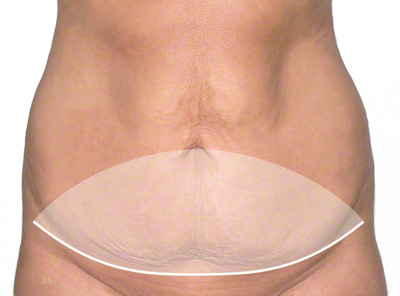
FAQ: Tummy tuck
What are the indications for a tummy tuck?
The main reasons for getting a tummy tuck (abdominal wall tightening procedure) are changes as a result of pregnancies (often multiple pregnancies) and massive weight loss after being severely overweight (obesity = adiposity, or the extreme form = morbid obesity).
On the one hand, the abdominal skin can be massively stretched. On the other, the abdominal wall, which is composed of abdominal musculature and firm fibrous tissue, is often also enlarged. Even in slender women, the latter can lead to a small, round belly. A simple tummy tuck at the skin level would not suffice. Interior tightening of the abdominal wall is important as well.
A severe separation of the abdominal musculature in the midline, called diastasis recti, can be corrected with an abdominoplasty at the muscle level (see below: inner corset).
Excessive weight loss, which in principle involves similar changes, is often given as the indication for a tummy tuck, in which an enormous excess of skin and fat (panniculus) takes center stage.
What is the typical order of events?
Smoking must be stopped for 2 weeks before a tummy tuck to minimize the risk of disturbance to wound healing. After wound healing is complete, the danger is no longer present. About 2 hours need to be allowed for the surgery. It is performed under general anesthesia. The incision is dependent on the amount of the tissue to be reduced. Depending on the extent of the tummy tuck, a hospital stay of 1-2 days is recommended, or even longer if removal of excessive tissue is anticipated.
With what other surgeries is the abdominoplasty often combined?
- The circular incision line is used if there is also an excess of skin in the area of the lower back, or if a buttock lift must also be performed.
- Combinations of tummy tuck with liposuction are often offered. It may be desired that the hip pads match the abdomen, or for the abdominal fat to be somewhat thinned out.
- When women lose weight, the breasts usually sag as well, so in this case a tummy tuck can be done simultaneously with a breast lift.
What is meant by the “inner corset” in terms of an abdominoplasty?
When a tummy tuck is performed, it should be kept in mind that over-stretching the tissues can affect the abdominal wall and abdominal muscles.
If the two large vertical abdominal muscles (m. rectus abdominis) separate from each other, in addition to simple slackening of the abdominal skin, a so-called diastasis recti develops.
One can solve such challenges that arise during a tummy tuck through the use of a so-called “inner corset”. Inner tightening is possible using a particular suture technique in which the firm muscle sheaths, not the muscles themselves, are sutured. With this technique one achieves tightening in the horizontal as well as vertical direction.
The navel is repositioned.
In the classical tummy tuck / abdominoplasty, the navel is repositioned.
The described techniques for re-implanting the navel are as numerous as grains of sand on the beach. The goal of all the techniques is that the new navel look as natural as possible. To that end, though, only a few methods are suitable.
The skillful formation of the navel is an important part of the tummy tuck, because it cannot be hidden by a bikini or bathing trunks.
Effectively, a funnel is formed in the abdominal wall and the scar is, to a large extent, hidden within it.
What is the “champagne groove?”
In colloquial speech, a deepening between the vertical abdominal muscles is known as a “champagne groove” in Germany.
Some people find it especially attractive. If desired by the patient, it is possible to form this during a tummy tuck procedure.
What needs to be considered when the tummy tuck is combined with liposuction?
The tummy tuck / abdominoplasty can be sensibly combined with liposuction.
In many cases, it’s true, there is a slackening of the abdominal skin, but there is also clearly excess fat tissue. In such situations, liposuction can be performed first, followed by the tummy tuck.
Our plastic surgeons carry out both procedures, one directly after the other, to avoid another anesthesia and to prevent our patients from undergoing two postoperative recoveries.
Others argue that the risk of disturbance to wound healing is greater because of the manipulation of the fat tissue during the liposuction and favor a second procedure, so as not to increase the risk of complications after the tummy tuck.
What about the upper tummy tuck?
The upper tummy tuck is a seldom-employed technique. It offers a possibility for patients who wish to have, for example, a breast reduction or breast lift carried out simultaneously with the tummy tuck.
The incision line in the inframammary fold used for the breast intervention is used for the tummy tuck as well. The skin of the upper abdomen, along with the underlying fat tissue, is pulled upward, and the excess is removed at the level of the inframammary fold.
The disadvantage however, lies in that the two lower breast incisions must be joined in the middle in order to remove sufficient tissue in this area as well. Right here, in the area of the breast bone, ugly, bulging hypertrophic scars frequently occur, even when skillful suture technique is used.
If the tissue excess lies not only in the upper abdomen, this technique can be combined with a small lower abdominoplasty. In this instance, the naval does not need to be repositioned.
Taken as a whole, this type of tummy tuck is employed only in exceedingly rare cases.
How is the panniculectomy (removal of the fat apron) different?
A special form of tummy tuck is the panniculectomy (removal of the fat apron). In most cases, the patients who get this intervention are still overweight.
The complete classical tummy tuck is not recommended in this case. Because of the total mass of fat tissue, which tends to have a poor blood supply, complications occur at a significantly higher rate, including the following: disturbances of wound healing, infections, fat necrosis (dying off of fat tissue) and hematomas, among others.
The operation is reduced to the minimum necessary in order to keep the resultant wound area as small as possible.
The panniculectomy is performed through the horizontal incision described above. The wound is then sutured in multiple layers.
The navel is not repositioned, and the dissection of the abdominal wall is carried out only up to the navel, and not, as in the tummy tuck, to the breast bone. Consequently the wound area is smaller.
Because of this, an improved blood supply reaches the wound margins, and the risk of disturbance of wound healing is minimized.
Meeting the costs of a tummy tuck
In Germany health insurance companies cover the costs of a tummy tuck less and less. A chance exists, however, in extreme cases that are clinically significant, similar to breast reduction.
What should be considered in the postoperative care and recovery of the tummy tuck?
- Drains
Drains are left in place for 2-5 days after the tummy tuck, depending on the volume of discharge. - General conduct
Especially in the first 3 weeks of recovery, one must be careful not to put much strain on the sutures in the lower abdomen so they do not stretch. One should therefore sleep in a jackknife position on one’s back to reduce the tension on the suture line. After the tummy tuck, walking and standing should be done in a position bent slightly forward. Regulation of the stool is just as important, and the danger of constipation (obstipation) can be prevented by use of a mild laxative. Constipating and gas-forming foods must be avoided. With strong pressure, the inner corset sutures can be quickly stretched again beyond what is wished for. - Compression
It is important to keep quiet in the first 24 hours after a tummy tuck so that small vessels that had been tied off do not open up again. By wearing a compression bandage for one night, the likelihood of bleeding is additionally reduced. In the first days and weeks of recovery, swelling and mild bruising of the skin (often different from one side to the other) are normal. A compression girdle should be worn for a full 6 weeks after the tummy tuck. - Stitches
Resorbable stitches do not need to be removed. Non-resorbable stitches are removed after 14 days at the earliest. - Showering
Because of the proximity to the pubic area, waterproof bandages are avoided for the most part. Showering is allowed shortly after removal of the drains (2-5 days). Prior to that the bandage must remain dry. - Sports
Strenuous sports and those that involve abdominal movement should be avoided for 4-6 weeks after surgery. These weeks are the total recovery time.
What complications can occur during the tummy tuck surgery?
In the following, the most important complications that can occur with a tummy tuck surgery are briefly described:
- Postoperative swelling
After the tummy tuck, a certain amount of postoperative swelling is normal. It can be in the form of smaller bruises or more pronounced in wound effusions. A certain amount of induration (hardening) is also normal postoperatively. These changes improve appreciatively in the first postoperative weeks. In this phase, compression products are urgently recommended and should be worn for 6 weeks after surgery. Of course, even after that, mild to moderate swelling might be visible. On occasion, one can also see swelling directly over the scar, which is explained by lymph blockage. This lymphatic swelling is also observed after C-section; it reduces in size but often takes months. - Hematomas
In this surgery, large wound surfaces are produced. Therefore it is especially important to carry out meticulous hemostasis. With subsequent compression and insertion of drains, large hematomas in patients without clotting disorders are rather rare. The body can resolve smaller hematomas itself; larger ones require an operative removal on an as-needed basis. - Bleeding
This is avoided as a rule by use of careful hemostasis and compression during surgery. Items described under hematomas apply here as well. - Disturbance of scar formation after the tummy tuck
So-called hypertrophic scars (or, in the worse cases, keloids) can occur occasionally in people with corresponding disorders. - Injury to adjacent structures (very rare)
If an abdominal wall hernia or umbilical hernia are present, the bowel can be injured. - Infections
The risk of infection should be reduced through highly sterile conditions, and, if necessary, antibiotic prophylaxis. - Dog ears
Excess skin is present on both ends of the horizontal cut surfaces. The worse the findings, the more extensive the tissue and even more extensive the amount of excess skin that must be removed during the tummy tuck surgery. They are called dog ears because of the resemblance. Removing these surgically is only done with caution in abdominoplasties to prevent excessive widening of the scar. They can be reduced using special suture techniques. It is hoped that they will shrink within 3-6 months and eventually will not be visible. If the desired shrinking effect is not sufficient, then a small revision under local anesthesia can be carried out. With this approach, one can usually keep scar lengths to a minimum. - Skin sensation in the scar area
Before the tummy tuck, it should be explained that there will be decreased sensation or numbness in the central scar area. Complete loss of feeling is rather rare. However, permanent numbness can remain in the upper half of the median scar segment. This is often already present after a C-section. - “Grief corner” (problem area)
The problem area (“grief corner”) in tummy tuck surgery is localized over the mons pubis. Here the greatest tension exists, and therefore a higher risk for disturbance in wound healing. A minimal disturbance in healing means a mild separation of the edges of the wound in this area. With antiseptic bandages this small problem can be quickly fixed. Larger disturbances of healing are rarer and usually occur in smokers or diabetics. - Tearing of the wound / sutures
With too much tension and too much movement of the torso, the sutures can become overstrained and tear. Therefore, especially in the first week after the tummy tuck, one should take care of oneself and remain in a slightly flexed position. - Dying off of tissue
It is possible, especially in heavy smokers, that the perfusion of the skin is no longer viable in the area of the greatest stress, in the middle of the suture line. In this case, portions of the skin can die off. Depending on the size of the defect, this can require the application of antiseptic bandages for a prolonged period of time, or even lead to further surgical revision. Therefore it is important to avoid cigarettes before and after a tummy tuck. - Wound serous effusion = seroma
In the tummy tuck, relatively large wound surfaces exist, which can produce wound drainage, depending on individual predisposition. Usually this does not develop into changes that are worth mentioning. Sometimes smaller and mid-sized seromas develop, which resolve on their own with time. The larger seromas must sometimes be drained using a cannula. - Unsatisfactory cosmetic results
In the setting of an effective counseling interview, the expectations of the patient and the possible operative results should be brought into accord to prevent disappointments. For asymmetric, suboptimal scar healing, among other problems, surgical revision can provide a remedy. - Thrombosis and embolism after a tummy tuck
Thrombosis prophylaxis with Heparin and support hose is advisable during and after surgery. - The risks of narcotics / anesthesia will not be addressed here.
Checking the facts
- Surgeons: Dr. Schumann und Dr. Schumann-Averkiou
- Treatment duration: approx. two hours
- Anaesthesia:
general anesthesia - Hospital:
1-2 days or more in hospital - Postoperative care:
Compression for about six weeks, relieving postures for three weeks - Sport:
Avoid it for about six weeks after the surgery.
Further information
Liposuction
It is not unusual for a tummy tuck to be combined with liposuction. Most frequently the hips are reduced to improve the contour of the waist.
